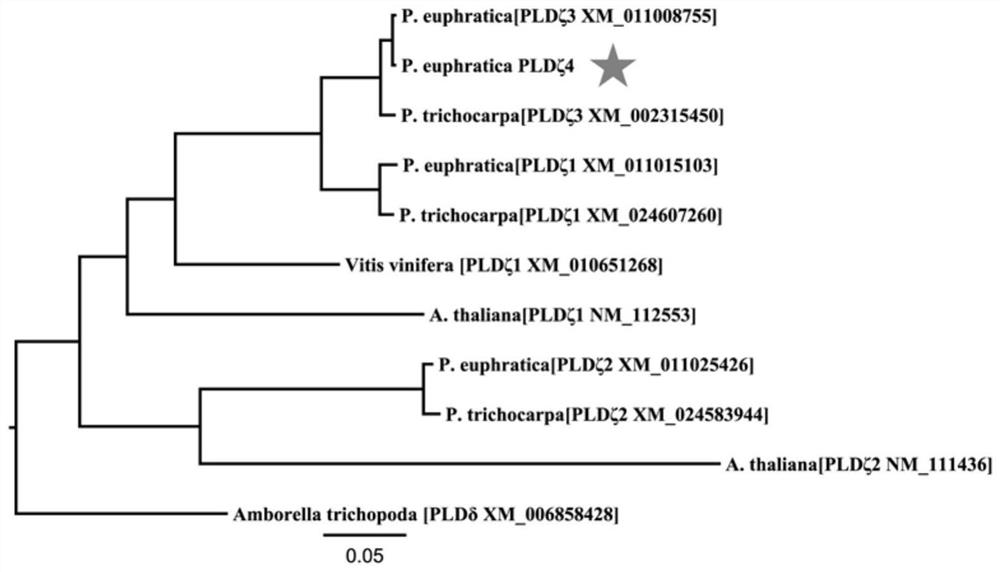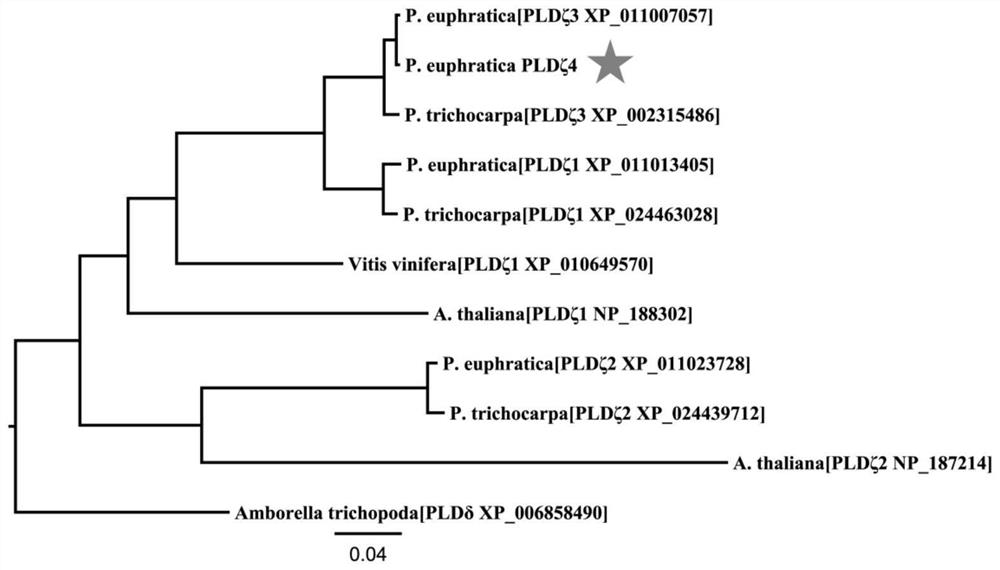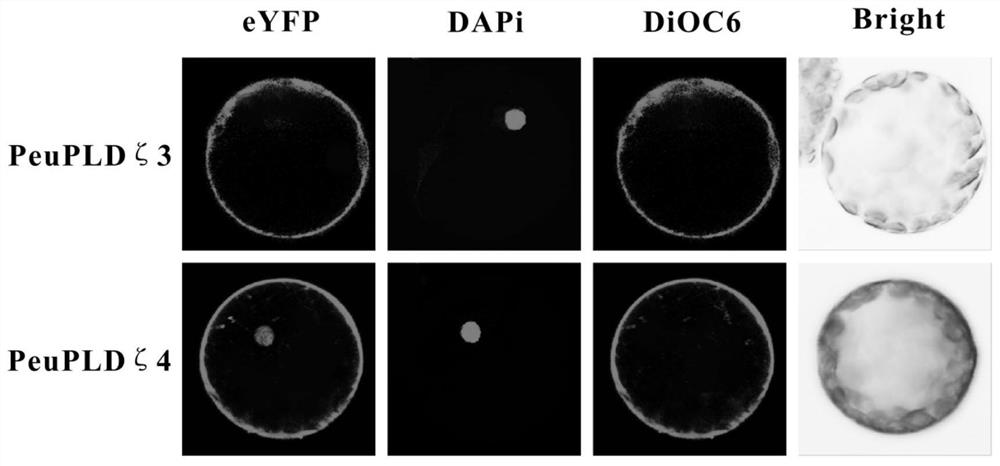Phospholipase D gene for promoting plant root development and application thereof
A plant root system and phospholipase technology, applied in the biological field, to achieve the effects of promoting plant breeding, improving utilization efficiency, and enhancing growth
- Summary
- Abstract
- Description
- Claims
- Application Information
AI Technical Summary
Benefits of technology
Problems solved by technology
Method used
Image
Examples
Embodiment 1
[0043] Embodiment 1 promotes the cloning of the phospholipase D gene PeuPLDζ4 sequence of root system development and homologous gene PeuPLDζ3
[0044] Utilize 2% CTAB (W / V), 2% PVP (W / V), 25mmol / L EDTA, 100mmol / L Tris-HCl pH 8.0, 2.0mol / L NaCl, 0.5g / L spermidine. After sterilization, add 2% (V / V) β-mercaptoethanol) method to extract total RNA of Populus euphratica leaf tissue, and its specific method is:
[0045] Collect 1 g of fresh Populus euphratica leaf tissue material, immediately place it in liquid nitrogen and grind it into powder, add it to a 1.5ml centrifuge tube, then add 800 μl CTAB preheated at 65°C, mix well, and put it in a water bath at 65°C for 8 minutes; add 1ml CI ( Chloroform: isoamyl alcohol = 24:1) solution, mix well, 4°C, centrifuge at 12000g for 10min; transfer the supernatant aqueous phase to a new 1.5ml centrifuge tube, add 1ml CI solution, mix well, 4°C, 12000g Centrifuge for 10 min; transfer the 2 tubes of the supernatant aqueous phase to a new 1.5...
Embodiment 2
[0057] Example 2 Subcellular localization of PeuPLDζ3 / 4 gene
[0058] Construction of Populus euphratica PeuPLDζ3 and PeuPLDζ4 genes respectively fused with yellow fluorescent protein YFP expression vectors: the sequence-verified fragments obtained in Example 1 were recombined into pDONR / Zeocin vectors by BP reaction, transformed into E. The entry clone was obtained by Zeocin screening, and then the plasmid was extracted, and the PeuPLDζ3 and PeuPLDζ4 genes were recombined into the pEarleyGate 101 vector by LR reaction, transformed into Escherichia coli DB3. Expression vectors pEarleyGate 101-PeuPLDζ3 and pEarleyGate 101-PeuPLDζ4.
[0059] Preparation of Arabidopsis protoplasts: Arabidopsis protoplasts were prepared strictly according to the method reported by Yoo et al. in Nature Protocol in 2007. Briefly, 10-15 pieces of Arabidopsis leaves that were 4 weeks old after germination were cut, Cut into strips with a width of about 0.5-1mm, put in 10ml enzyme solution [20mM MES (...
Embodiment 3
[0062] Example 3 Identification of the expression pattern of Populus euphratica PeuPLDζ4
[0063] Sequence analysis was carried out by bioinformatics method, and the primer sequences of PeuPLDζ3 and PeuPLDζ4 promoters were designed.
[0064] PeuPLDζ3 promoter region primers:
[0065] 5' end primer: ATCAGTGATCTTCGCAGGTCG
[0066] 3' end primer: GAATGGTTGGTTTGGGGTTT
[0067] PeuPLDζ4 promoter region primers:
[0068] 5' end primer: AGCCACGCTCTGTTGATCTTCC
[0069] 3' end primer: CGAATGGTTGGTTTGGGGTTT
[0070] Utilize CTAB (2% CTAB (W / V), 20mmol / L EDTA, 100mmol / L Tris-HCl pH 8.0, 1.4mol / L NaCl, 1% (V / V) β-mercaptoethanol) method to extract total tissue of Populus euphratica leaf tissue DNA, the specific method is:
[0071] Collect 1g of fresh Populus euphratica leaf tissue material, immediately place it in liquid nitrogen and grind it into powder, add it to a 2.0ml centrifuge tube, then add 800μl CTAB preheated at 65°C, mix well, put it in a water bath at 65°C for 60min, and...
PUM
 Login to View More
Login to View More Abstract
Description
Claims
Application Information
 Login to View More
Login to View More - R&D
- Intellectual Property
- Life Sciences
- Materials
- Tech Scout
- Unparalleled Data Quality
- Higher Quality Content
- 60% Fewer Hallucinations
Browse by: Latest US Patents, China's latest patents, Technical Efficacy Thesaurus, Application Domain, Technology Topic, Popular Technical Reports.
© 2025 PatSnap. All rights reserved.Legal|Privacy policy|Modern Slavery Act Transparency Statement|Sitemap|About US| Contact US: help@patsnap.com



